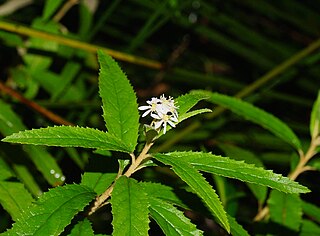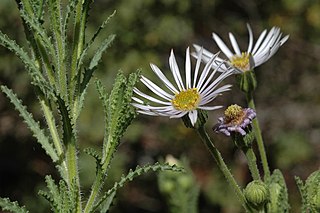
Olearia flocktoniae, commonly known as Dorrigo daisy bush, is a species of flowering plant in the family Asteraceae and is endemic to a restricted area of New South Wales. It is a shrub with crowded, linear leaves, and white and yellow, daisy-like inflorescences.
Olearia cuneifolia is a species of flowering plant in the family Asteraceae and is endemic to Queensland. It is an erect shrub with lance-shaped to wedge-shaped leaves and white, daisy-like inflorescences.
Olearia curticoma is a species of flowering plant in the family Asteraceae and is endemic to Victoria. It is an erect shrub with glabrous, sticky branchlets, linear leaves and white and yellow, daisy-like inflorescences.
Olearia elaeophila is a species of flowering plant in the family Asteraceae and is endemic to the south-west of Western Australia. It is a small shrub with scattered linear leaves, and white or blue and yellow, daisy-like inflorescences.
Olearia eremaea is a species of flowering plant in the family Asteraceae and is endemic to inland areas of Western Australia. It is a shrub with scattered, more or less elliptic leaves, and white and yellow, daisy-like inflorescences.
Olearia fluvialis is a species of flowering plant in the family Asteraceae and is endemic to inland areas of northern Western Australia. It is a shrub with scattered, narrowly egg-shaped leaves, and white or mauve and yellow, daisy-like inflorescences.

Olearia glandulosa, commonly known as swamp daisy-bush, is a species of flowering plant in the family Asteraceae and is endemic to south-eastern Australia. It is a slender, erect, glabrous shrub with sticky, narrowly linear leaves and white or pale blue and yellow, daisy-like inflorescences.

Olearia gravis is a species of flowering plant in the family Asteraceae and is endemic to south-eastern Australia. It is a shrub with elliptic or egg-shaped leaves and white and yellow, daisy-like inflorescences.

Olearia heterocarpa, commonly known as Nightcap daisy bush, is a species of flowering plant in the family Asteraceae and is endemic to eastern Australia. It is a shrub with narrowly elliptic or lance-shaped leaves with toothed edges, and white and yellow, daisy-like inflorescences.

Olearia humilis is a species of flowering plant in the family Asteraceae and is endemic to the south-west of Western Australia. It is an erect, spindly shrub with narrowly egg-shaped or linear leaves, and purple and yellow, daisy-like inflorescences.
Olearia hygrophila, commonly known as swamp daisy or water daisy, is a species of flowering plant in the family Asteraceae and is endemic to a restricted part of North Stradbroke Island in south-eastern Queensland. It is a shrub with slender stems, linear leaves and white and yellow, daisy-like inflorescences.
Olearia incana is a species of flowering plant in the family Asteraceae and is endemic to southern Australia. It is a shrub with narrowly elliptic or wedge-shaped leaves and white and pale yellow, daisy-like inflorescences.
Olearia incondita is a species of flowering plant in the family Asteraceae and is endemic to the south-west of Western Australia. It is a straggly shrub with narrowly elliptic leaves and white or pink and yellow, daisy-like inflorescences.

Olearia laciniifolia is a species of flowering plant in the family Asteraceae and is endemic to inland areas of the south-west of Western Australia. It is an erect shrub with scattered oblong leaves with small lobes on the edges, and lilac, white and yellow, daisy-like inflorescences.
Olearia lehmanniana is a species of flowering plant in the family Asteraceae and is endemic to inland areas of the south-west of Western Australia. It is a shrub with scattered elliptic or linear leaves that are densely hairy on the lower surface, and pale mauve, daisy-like inflorescences.
Olearia mucronata is a species of flowering plant in the family Asteraceae and is endemic to inland areas of Western Australia. It is a densely-branched, unpleasantly aromatic shrub with crowded linear leaves, and white and yellow, daisy-like inflorescences.

Olearia muricata, commonly known as rough-leaved daisy bush, is a species of flowering plant in the family Asteraceae and is endemic to the south-west of Western Australia. It is an erect shrub with flat, linear to triangular leaves, and white or pale mauve and yellow, daisy-like inflorescences.
Olearia newbeyi is a species of flowering plant in the family Asteraceae and is endemic to the south-west of Western Australia. It is a shrub with broadly linear to narrowly oblong leaves, and dull purple, daisy-like inflorescences.
Olearia occidentissima is a species of flowering plant in the family Asteraceae and is endemic to the extreme west of Western Australia. It is an erect or prostrate, wind-pruned shrub with narrowly elliptic leaves that are woolly-hairy on the lower surface, and white, daisy-like inflorescences.
Olearia plucheacea is a species of flowering plant in the family Asteraceae and is endemic to inland Western Australia. It is an erect, open shrub with scattered hairy, thread-like to linear leaves, and white and yellow daisy-like inflorescences.






